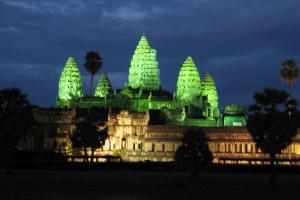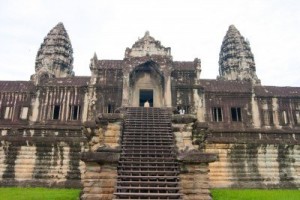Angkor Wat Facts
Part of an ancient Cambodian capital, Angkor Wat was the spiritual epicentre of the Khmer Empire.
Angkor Wat is a temple complex in north-west Cambodia. Today it is an archaeological site, but from the early to mid-12th century Angkor was the capital city of the Khmer Empire – one of the most powerful civilisations in south-east Asia.
The complex, which was largely built by Khmer king Suryavarman II, was in dedication to the Hindu god Vishnu and, upon completion, covered an area of 820,000 square metres (8.8 million square feet), with numerous towers, temples, courtyards and dwellings encircled by a stone wall. The temple complex was accessed by an earth bank to the east and a sandstone causeway to the west – the latter being the main entrance for officials and royalty.
At the centre of the complex lay a quincunx of large ornate towers (positioned like the five dots on a die), which represented the spiritual Mount Meru – the home of the Hindu gods. The five towers symbolised the five peaks of the mountain, while the surrounding moat represented the ocean that was supposed to surround them. These central towers, as well as the inner temple, were only open to the royal family and high-ranking officials.
Surrounding the central temple was a large outer enclosure that originally would have housed the majority of the city’s dwellings. These were built out of wood and other easily perishable materials and, as a result, no record of them survives today, with the majority of the outer enclosure now densely populated with jungle vegetation. To the north of the temple lay the royal palace, while a selection of grand stone libraries sat in the peripheries.
 Today Angkor Wat is a central part of the Angkor Archaeological Park, a UNESCO World Heritage Site that encompasses 400 square kilometres (152 square miles) of temples, forest and hydraulic structures such as reservoirs and canals dating from the 9th to 15th century.
Today Angkor Wat is a central part of the Angkor Archaeological Park, a UNESCO World Heritage Site that encompasses 400 square kilometres (152 square miles) of temples, forest and hydraulic structures such as reservoirs and canals dating from the 9th to 15th century.
Who was Suryavarman II?
Suryavarman II was the king of the Khmer Empire from 1113-1150 CE. His reign was typified by a number of military campaigns, the restoration of a strong central ruling class among the Khmer peoples and, most importantly, the formulation and construction of the Angkor Wat temple complex – the latter built in dedication to the Hindu god Vishnu. He was succeeded by his cousin Dharanindravarman II.
Facts about Angkor Wat
 Library – Sitting either side of the western gate within the outer courtyard are two ornamental library structures. They have four entrances each.
Library – Sitting either side of the western gate within the outer courtyard are two ornamental library structures. They have four entrances each.
Sanctuary – At the centre of the four other towers sits a larger one, creating a quincunx. This was the temple’s central sanctuary and was very exclusive.
Tower – Angkor Wat rises towards the centre on a series of colonnaded platforms, in the corners of which stand four towers shaped like upturned lotus buds.
Walkway – The outer walls of the temple are 4.5m (15ft) high and double up as walkways with a balustrade. These are covered with ornate carvings and bas-reliefs.
Gallery – A series of four interlocked, square galleries lie behind the main western gate. These offer access to both the outer and inner courtyards.
